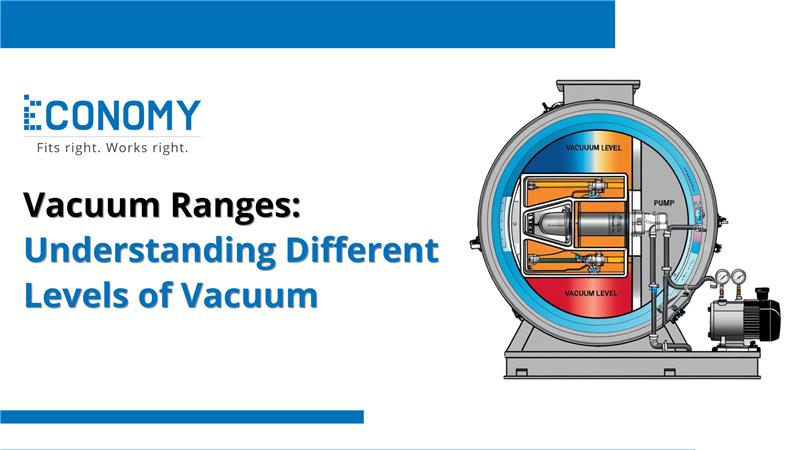What Is a Vacuum?
In scientific and industrial contexts, a vacuum refers to a space where gas pressure is lower than atmospheric pressure. Rather than a total absence of matter (which is almost impossible to achieve), a vacuum simply indicates that fewer gas molecules are present. This reduced pressure environment is critical in many fields—from electronics manufacturing to chemical processing—where controlling the presence of gases can directly impact product quality or process efficiency.
Vacuum is not a one-size-fits-all concept; it exists on a spectrum defined by how much air or gas has been removed. Understanding this spectrum is key to applying vacuum technology effectively.
What Are Vacuum Ranges?
Vacuum ranges categorize levels of pressure reduction relative to atmospheric pressure (typically around 1013 mbar at sea level). These ranges help in selecting the correct equipment and procedures for specific applications. They’re usually defined as:
-
Low (or rough) vacuum
-
Medium vacuum
-
High vacuum
-
Ultra-high vacuum (UHV)
-
Extreme or deep vacuum
Each range requires different equipment, sealing techniques, and operational protocols. The lower the pressure, the more precise and demanding the system becomes.
Different Types of Vacuum Levels and Their Applications
-
Low Vacuum (Rough Vacuum)
-
Range: 1013 to ~1 mbar
-
Typical uses: Food packaging, vacuum forming, air conditioning system evacuation, and lab filtration.
-
Equipment: Rotary vane, diaphragm, or scroll pumps.
-
This is the easiest vacuum range to achieve and is sufficient for processes where only a moderate reduction in air pressure is required.
-
-
Medium Vacuum
-
Range: 1 to 10⁻³ mbar
-
Applications: Vacuum drying, degassing of liquids, coating processes, and metallurgy.
-
Equipment: Backed turbomolecular or roots pumps.
-
This range often serves as a bridge between roughing stages and high vacuum conditions in multi-stage systems.
-
-
High Vacuum
-
Range: 10⁻³ to 10⁻⁷ mbar
-
Common uses: Mass spectrometry, thin-film deposition, and electron beam welding.
-
Equipment: Turbomolecular pumps, ion pumps, and cold traps.
-
At this level, molecular flow dominates, requiring advanced system design and extremely clean environments.
-
-
Ultra-High Vacuum (UHV)
-
Range: Below 10⁻⁷ mbar
-
Industries: Particle physics research, nanotechnology, and semiconductor fabrication.
-
Requirements: Special materials (e.g., stainless steel), extensive bake-outs, and leak testing.
-
Achieving UHV is a complex process involving careful system conditioning and ultra-clean handling.
-
-
Extreme High Vacuum (XHV)
-
Range: Below 10⁻¹² mbar
-
Uses: Advanced research experiments in quantum physics or deep space simulation.
-
This level pushes the limits of modern technology and is rarely used outside of highly specialized labs.
-
Factors Affecting Vacuum Levels
Achieving and maintaining a specific vacuum level depends on several interconnected factors:
-
System leaks: Even microscopic leaks can drastically reduce achievable vacuum levels, especially in high or ultra-high vacuum systems.
-
Outgassing: Materials in the chamber can release absorbed gases over time, increasing pressure. Pre-baking and material selection help reduce this.
-
Pumping configuration: The choice and arrangement of pumps—whether single-stage or multistage—impact how low you can go in pressure.
-
Seal materials: O-rings and gaskets made of materials like Viton or copper must be compatible with the desired vacuum range.
-
Cleanliness: Contaminants, especially oils or moisture, can significantly affect performance. Cleaning procedures and oil-free systems are often necessary for cleaner vacuum levels.
How to Choose the Right Vacuum Range for Your Application?
Selecting the appropriate vacuum range starts with understanding your process requirements and technical constraints:
-
Define your end goals: Are you removing moisture, processing chemicals, or creating a clean experimental space? The purpose dictates the pressure level needed.
-
Evaluate material compatibility: Some applications demand oil-free or corrosion-resistant systems, which affect vacuum design.
-
Match to the right pump: Rough vacuum applications may only need a rotary pump, while high or UHV conditions require turbomolecular or cryogenic systems.
-
Consider system design: Vacuum chambers, lines, and fittings must be compatible with your desired pressure. A poorly designed system can limit your achievable vacuum.
-
Account for budget and maintenance: Advanced vacuum systems can be costly and require routine upkeep. Ensure you have the resources for long-term operation and reliability.
Conclusion
Understanding vacuum ranges isn’t just about knowing pressure numbers—it’s about aligning technical possibilities with practical application needs. Whether you’re designing an industrial drying system or conducting space-grade research, selecting the right vacuum level is essential for efficiency, precision, and performance. By factoring in materials, equipment, environmental conditions, and goals, you can build a vacuum system that truly supports your operation at every level.





